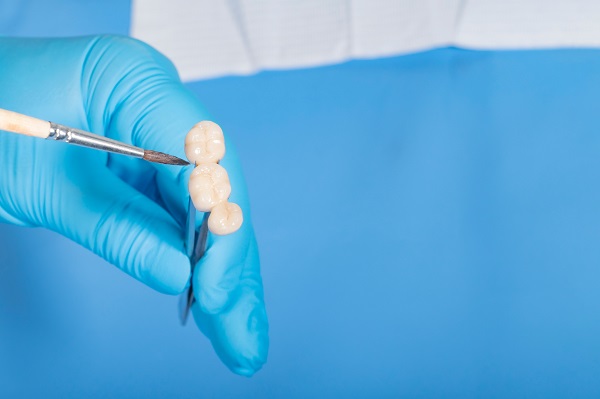How Dental Bridges Can Improve Your Smile

For people who have missing teeth, dental bridges can be used to improve the appearance and restore the function of their teeth. This treatment is particularly beneficial for patients who have one or more missing front teeth.
Dental bridges
A bridge consists of crowns that are placed on both sides of the missing tooth or teeth that provide support for a false tooth or teeth. Dental bridges are cemented into place and are not removable by the patient, unlike partial dentures. The artificial teeth are designed to closely match the appearance and function of natural teeth.
Who can get a dental bridge?
People who have one or more missing teeth but have healthy teeth on at least one side of the missing tooth or teeth can usually get dental bridges.
What are the benefits of a dental bridge?
When a person has a missing tooth, the adjacent teeth or the teeth in the patient's opposite jaw may move into the empty space. This can cause a variety of problems:
- Bite issues
- Teeth and jaw stress that causes pain
- Difficulty chewing and speaking
- Changes in appearance
Dental bridges fill the empty space, preventing other teeth from shifting positions, making it easier to chew and bite, and improving the appearance of the smile. Filing the gaps in your teeth can also restore your ability to speak and pronounce words and prevent changes in the shape of your face. Additionally, replacing your lost teeth can fix bite issues by properly distributing bite forces.
Is there more than one kind of dental bridge?
There are four main types of dental bridges. The most commonly used is the traditional fixed bridge. This bridge has at least two crowns and one or more artificial teeth that are connected to each other. The crowns support the bridge and hold it in place. Traditional bridges are constructed of metal, ceramic, or porcelain fused to metal.
Implant-supported bridges are similar to the traditional fixed bridge. However, the bridge is held in place by implants instead of cement.
The cantilever bridge is an option for patients who only have teeth on one side of the missing tooth or teeth. This bridge is not as stable as the traditional bridge because it only attaches to one adjacent tooth.
The Maryland bridge is most commonly used for people with missing front teeth. Instead of being supported by crowns on the teeth next to the gap, the bridge is supported by a framework with wings on each side.
How long do bridges last?
Most dental bridges last between five and seven years. Some may last as long as 10 years.
Do dental bridges need special care?
Because tooth decay can cause your bridge to fail, it is particularly important to take steps to prevent it. Brush your teeth twice per day and floss once per day. Schedule regular checkups so that your dentist can find any problems with your teeth, gums, or bridge early. Consume a balanced diet that includes vegetables, fruit, and fiber. Limit the amount of fibrous, chewy foods you consume.
Dental bridge procedure
Most dental bridge procedures require at least two appointments. During the first appointment, the dentist removes some of the enamel and dentin on the teeth that will support the bridge. This makes room for the crowns.
Next, the dentist makes an impression or takes a digital scan of the teeth. This scan or impression is sent to a dental laboratory and used to manufacture the bridge, crowns, and artificial teeth. The dentist places a temporary bridge to protect the patient's mouth while the permanent bridge is being made.
When the permanent bridge is ready, the patient returns for a second visit. The dentist removes the temporary bridge and replaces it with the permanent bridge. Finally, the dentist checks the fit and appearance of the bridge and makes any necessary adjustments.
Are there any potential complications?
Many patients do not experience any complications. However, tooth decay in the surrounding teeth or deterioration of the cement may result in the bridge failing. If this happens, your dentist may be able to reattach it. If you notice any bite changes, chewing becomes uncomfortable or you have swelling, bleeding, redness, or pain around your bridge, contact your dentist or healthcare provider.
Conclusion
Dental bridges improve smiles by restoring the look and function of missing teeth. If you are missing teeth, your dentist can recommend treatment options, such as dental bridges, that may help.
Request an appointment here: https://www.gledhilldental.com or call Gledhill Dental at (509) 800-8410 for an appointment in our Kennewick office.
Check out what others are saying about our dental services on Yelp: Dental Bridges in Kennewick, WA.
Related Posts
Dental bridges can replace missing teeth effectively and often without needing surgery. Not only will this restore the smile, but it also helps patients avoid the negative oral health effects of missing teeth. A general dentist can determine whether a patient is a good candidate for bridges in a consultation. However, learning the basics can…
A dental bridge is a reliable, effective solution for tooth loss, as it offers functional and aesthetic benefits. This dental restoration helps improve chewing, speech, and overall oral health while maintaining the smile’s natural structure. Patients interested in bridges as tooth replacements can benefit from learning more about their basics, placement process, and long-term care…
Dental bridges and implants are two of the options you get to choose from when it comes to replacing missing teeth. Both provide you with natural-looking artificial teeth that restore your smile and other functions of your teeth. Implants and bridges can even be combined to provide you with a hybrid solution.Not sure whether to…
Many dental patients are self-conscious about missing teeth. Depending on the exact teeth that have been lost, this condition can also make it difficult to chew food. In many cases, a dental bridge can be used to replace lost teeth and restore a patient's smile.As the name suggests, a dental bridge uses an artificial tooth…


